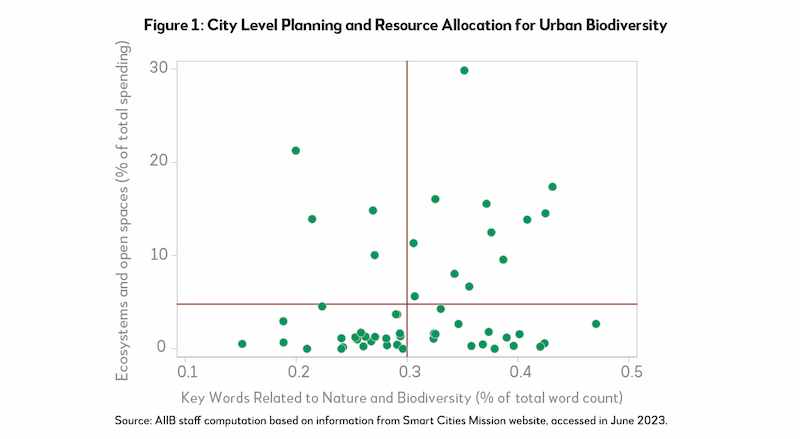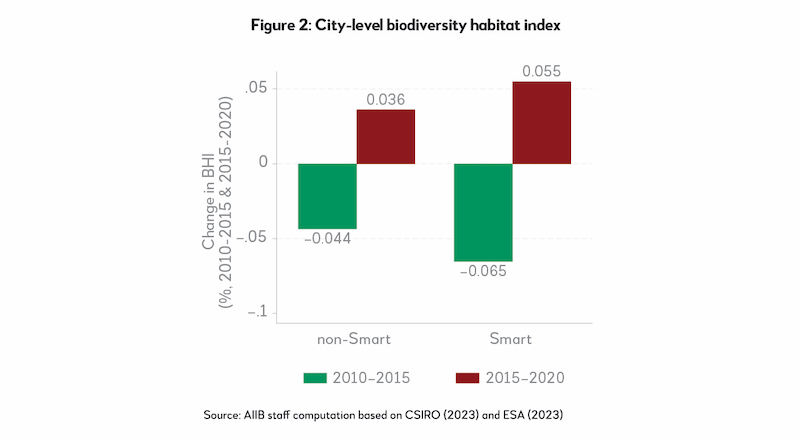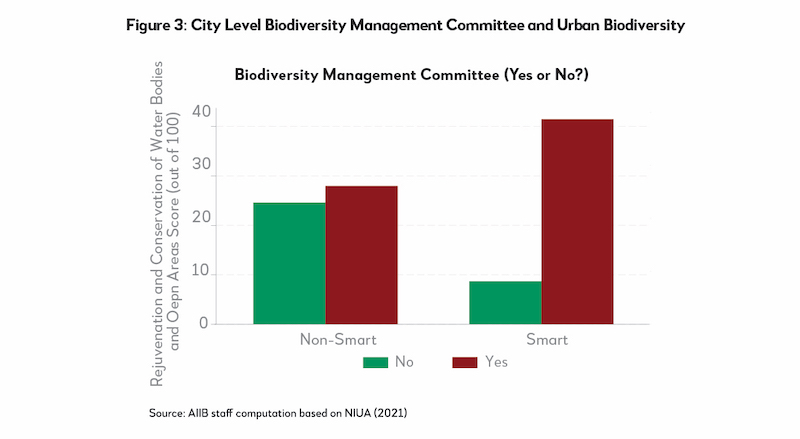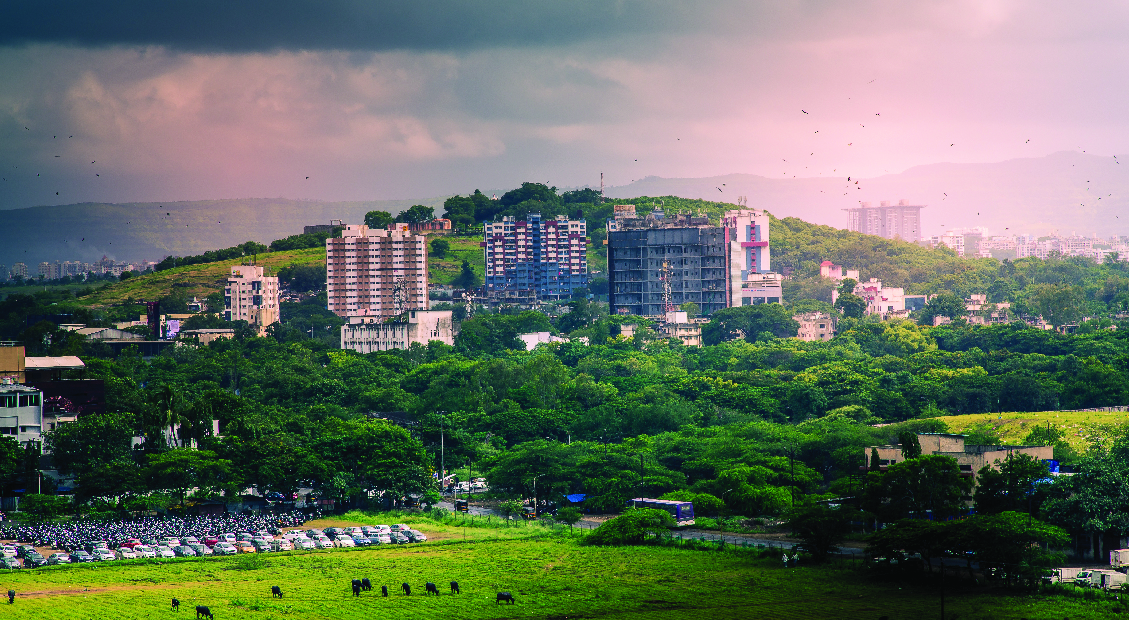By 2050, a staggering 840 million are expected to live in cities in India. These cities are expected to be the fulcrum of economic activities. However, cities must expand in a sustainable manner to realize their full potential. The current pattern of urbanization has adverse consequences, which are plainly evident as many cities in India are highly polluted, posing challenges for environmental and ecological sustainability. Overcoming these challenges would require designing and implementing policies that foster ecologically sustainable growth.
India’s flagship urban development program, the Smart Cities Mission (SCM) seeks to provide urban residents both sustainable environment and core infrastructure in an effort to provide a decent quality of life. It emphasizes the planning, development, and maintenance of blue-green infrastructure.[i] This article evaluates how cities under the SCM have performed on three aspects related to urban biodiversity conservation: (a) budget and planning, (b) maintenance of green spaces and biodiversity habitats, and (c) the role of institutional capacity and governance.
First, we focus on how cities selected under the SCM match their planning intent with provision of funds. We proxy planning intent with the frequency with which words related to biodiversity appear in the SCM proposals. We find no systematic correlation between the share of funds allocated to conservation and restoration of ecosystems with the planning intent (Figure 1). A large number of the cities are bunched in the bottom right quadrant, reflecting high planning intent but low fund allocation. Aligning the planning and budgeting processes will potentially have a favorable effect on nature-positive outcomes. Thus, affirmative actions by cities to close such gaps through capacity building initiatives become an important part of such city-level programs.

Second, we look at whether cities selected under the SCM perform better in preserving natural capital by comparing their progress with another group of 24 cities that were not selected under the program. We find that over the last decade, both groups of cities experienced an erosion of green cover both before and after the introduction of the SCM. But the pace of the decline of green cover slowed down significantly more for the smart cities after their entry into the SCM, relative to other cities.
The effect of the introduction of SCM on biodiversity is more profound. Both non-smart and smart cities, which witnessed a worsening of biodiversity in the period before the SCM, experienced an improvement in biodiversity after their entry into the program. Here again, the smart cities outperform the non-smart cities with a more pronounced recovery. We confirm this through a formal difference-in-differences design (Figure 2).

The SCM has been found to positively impact biodiversity. Prior to the SCM, there was no difference in the biodiversity trend between smart cities and other cities. However, after the implementation of the program, there was an increase in biodiversity in smart cities compared to other cities. Similarly, the program was effective in slowing down the depletion of green cover in smart cities.
This begs the question: why did cities in the SCM program do better in biodiversity despite there being no obvious alignment between planning and fund allocation? We look at the role of the institutional capacity of the local government toward biodiversity conservation. It turns out that that the SCM framework gives impetus to existing institutions to perform better. For example, both smart and non-smart cities in this study had constituted Biodiversity Management Committees tasked to promote conservation and sustainable use of resources. Across both smart cities and other cities, those with such a committee scored better on rejuvenation and conservation of biodiversity-rich areas like water bodies and open areas. However, the difference was starker among smart cities, suggesting a relatively higher efficacy of such committees for smart cities on the rejuvenation and conservation score (Figure 3). Moreover, smart cities with such a committee allocated more resources towards ecosystems and open spaces.

In summary, our analysis indicates that cities in India have a significant potential to improve their nature-positive outcomes. Mainstreaming nature into their overall development plans is a major step forward and several cities have started to make encouraging progress in this regard. The SCM it turns out has been an effective, even if not directly intended, instrument in preserving natural capital. This finding highlights the importance of building upon the SCM as a means to enhance the preservation of natural resources. Thus, the strengthening of institutional, technical, and fiscal capacity of local governments, along with improved planning, assessment, and community-based conservation efforts, would have a positive impact on nature, and on the community, in general.
Note: This blog is adapted from Chapter 7 of the Asian Infrastructure Finance 2023: Nature as Infrastructure, one of AIIB’s flagship publications. The full report can be downloaded here.
References
IUCN (2023). Cities and Nature, Issues Brief, October 2023.
Almaaitah, T., Appleby, M., Rosenblat, H., Drake, J., & Joksimovic, D. (2021). The Potential of Blue-Green Infrastructure as a Climate Change Adaptation Strategy: A Systematic Literature Review.Blue-Green Systems,3(1), 223-248.
[i] Blue-green infrastructure are nature or nature-based systems that can mitigate climate change and biodiversity impact and enhance the liveability, sustainability, and resilience of urban areas [IUCN (2023); Almaaitah et. al (2021)].


